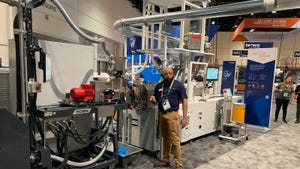K 2013: CreaSolve process finally makes effective recycling of metal-plastic composites feasible
Although cherished for such properties as strength, durability, low weight and low maintenance, composites are notoriously difficult to recycle. At K 2013, the Fraunhofer Institute for Process Engineering and Packaging IVV (Hall 07 / B05) will present a new variant of its solvent-based CreaSolv process that allows metal-plastic composites to be safely and efficiently separated and recycled, extracting maximum value from end-of-life components. Fraunhofer IVV is also presenting two other variants of the process that target expanded polystyrene (EPS), and polylactide (PLA).
August 13, 2013
CreaSolv is a patented, trademarked solvent-based process in which a target polymer is dissolved out of the waste mixture using a selective solvent formulation, after which the resulting polymer solution is cleaned - mechanically and by chemical extraction - and dried. The solvents are then returned to the cycle for reuse.
Decomposing metal-plastic composites
Until now, separating metal-plastic technical components, such as the galvanized complex-shaped parts that are produced by carmakers or the sanitary supply industry, or the plastic-covered metal distribution boxes, cable connectors and the like manufactured in the automotive and electronics industries, has been next to impossible. Current recycling processes allow only one component of the composite to be recycled, as technology was lacking to extract and recover the constituent materials in these components. The CreaSolv process now makes this technology available.
New approaches for recycling EPS and PLA
Lacking any appropriate purification and recycling technology, expanded polystyrene (EPS), used on a wide scale in the construction and packaging industries, is generally incinerated, as contamination makes effective recycling impossible. Fraunhofer IVV claims that its CreaSolv process offers efficient purification and is able to produce virgin-quality re-expandable polystyrene from EPS waste; the institute is currently collaborating on a new logistical plan for collecting EPS waste at low cost.
The two standard methods for recycling polylactide (PLA), combustion and composting, the two standard recycling methods used to date, look soon to be joined by a third. The mounting quantities of PLA packaging waste have led Fraunhofer IVV to conduct an evaluation of the entire process chain for PLA recycling, including possible effects of PLA on the recycling of other plastics. Fraunhofer IVV envisages a process that will allow pure PLA, PLA-containing fractions, PLA composites, and blends to be separated from packaging waste and processed into high-quality PLA recyclates. These recyclates can then be used for manufacturing high-quality packaging for non-food applications and for consumer goods.
You May Also Like

